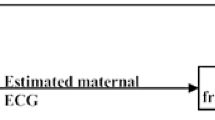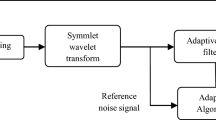Abstract
This paper proposes a five-stage based methodology to extract the fetal electrocardiogram (FECG) from the single channel abdominal ECG using differential evolution (DE) algorithm, extended Kalman smoother (EKS) and adaptive neuro fuzzy inference system (ANFIS) framework. The heart rate of the fetus can easily be detected after estimation of the fetal ECG signal. The abdominal ECG signal contains fetal ECG signal, maternal ECG component, and noise. To estimate the fetal ECG signal from the abdominal ECG signal, removal of the noise and the maternal ECG component presented in it is necessary. The pre-processing stage is used to remove the noise from the abdominal ECG signal. The EKS framework is used to estimate the maternal ECG signal from the abdominal ECG signal. The optimized parameters of the maternal ECG components are required to develop the state and measurement equation of the EKS framework. These optimized maternal ECG parameters are selected by the differential evolution algorithm. The relationship between the maternal ECG signal and the available maternal ECG component in the abdominal ECG signal is nonlinear. To estimate the actual maternal ECG component present in the abdominal ECG signal and also to recognize this nonlinear relationship the ANFIS is used. Inputs to the ANFIS framework are the output of EKS and the pre-processed abdominal ECG signal. The fetal ECG signal is computed by subtracting the output of ANFIS from the pre-processed abdominal ECG signal. Non-invasive fetal ECG database and set A of 2013 physionet/computing in cardiology challenge database (PCDB) are used for validation of the proposed methodology. The proposed methodology shows a sensitivity of 94.21%, accuracy of 90.66%, and positive predictive value of 96.05% from the non-invasive fetal ECG database. The proposed methodology also shows a sensitivity of 91.47%, accuracy of 84.89%, and positive predictive value of 92.18% from the set A of PCDB.


















Similar content being viewed by others
References
Panigrahy D, Sahu PK (2015) Extraction of fetal electrocardiogram (ECG) by extended state Kalman filtering and adaptive neuro-fuzzy inference system (ANFIS) based on single channel abdominal. Sadhana– Acad Proc Eng Sci Springer 40:1091–1104
Ocak H (2013) A medical decision support system based on support vector machines and the genetic algorithm for the evaluation of fetal well-being. J Med Syst. doi:10.1007/s10916-012-9913-4
Cattani C, Doubrovina O, Rogosin S et al (2006) On the creation of a new diagnostic model for fetal well-being on the base of wavelet analysis of cardiotocograms. J Med Syst 30:489–494. doi:10.1007/s10916-006-9037-9
Liszka Hackzell JJ (2001) Categorization of fetal heart rate patterns using neural networks. Journal-of-Medical-Systems 25:269–276
Behar J, Johnson A, Clifford GD, Oster J (2014) A comparison of single channel fetal ECG extraction methods. Ann Biomed Eng 42:1340–1353. doi:10.1007/s10439-014-0993-9
Panigrahy D, Rakshit M, Sahu PK (2015) An efficient method for fetal ECG extraction from single channel abdominal ECG. 2015 International. Conference on IEEE, 2015 Industrial. Instrumentation and Control.(ICIC) pp 1083–1088
Niknazar M, Rivet B, Jutten C (2013) Fetal ECG extraction by extended state Kalman filtering based on single-channel recordings. IEEE Trans Biomed Eng 60:1345–1352. doi:10.1109/TBME.2012.2234456
Zeng X, Zhou X, Li G, Liu Q (2012) Robust adaptive fetal heart rate estimation for single-channel abdominal ECG recording. 2012 5th International Conference on Biomedical Engineering and Informatics BMEI 2012 pp 587–591
Tal Y, Akselrod S (1989) Fetal heart rate detection by a special transform method. Proceedings of Computers in Cardiology pp 275–278
Ferrara ER, Widrow B (1982) Fetal electrocardiogram enhancement by time-sequenced adaptive filtering. IEEE Trans Biomed Eng 29:458–460. doi:10.1109/TBME.1982.324973
Abboud S, Alaluf A, Einav S, Sadeh D (1992) Real-time abdominal fetal ECG recording using a hardware correlator. Comput Biol Med 22:325–335. doi:10.1016/0010-4825(92)90021-E
Callaerts D, De Moor B, Vandewalle J et al (1990) Comparison of SVD methods to extract the foetal electrocardiogram from cutaneous electrode signals. Med Biol Eng Comput 28:217–224. doi:10.1007/BF02442670
Kanjilal PP, Palit S, Saha G (1997) Fetal ECG extraction from single-channel maternal ECG using singular value decomposition. IEEE Trans Biomed Eng 44:51–59. doi:10.1109/10.553712
Arias-Ortega R, Gaitán-González MJ (2010) Single channel abdominal ECG algorithm for real-time maternal and fetal heart rate monitoring. Rev Mex Ing Biomédica 32:111–118
Niknazar M, Rivet B, Jutten C (2012) Fetal ECG extraction from a single sensor by a non-parametric modeling. 20th European Signal Processing Confrence (EUSIPCO 2012), pp 949–953
Mochimaru F (2002) Detecting the fetal electrocardiogram by wavelet theory-based methods. Prog Biomed Res 7:185–193
Khamene A, Negahdaripour S (2000) A new method for the extraction of fetal ECG from the composite abdominal signal. IEEE Trans Biomed Eng 47:507–516. doi:10.1109/10.828150
Camps G, Martinez M, Soria E (2001) Fetal ECG extraction using an FIR neural network. Comput Cardiol doi:10.1109/CIC.2001.977639 (Cat no.01CH37287)
Camps-Valls G, Martínez-Sober M, Soria-Olivas E et al (2004) Foetal ECG recovery using dynamic neural networks. Artif Intell Med 31:197–209. doi:10.1016/j.artmed.2004.03.005
Assaleh K, Al-Nashash H (2005) A novel technique for the extraction of fetal ECG using polynomial networks. IEEE Trans Biomed Eng 52:1148–1152. doi:10.1109/TBME.2005.844046
Assaleh K (2007) Extraction of fetal electrocardiogram using adaptive neuro-fuzzy inference systems. IEEE Trans Biomed Eng 54:59–68. doi:10.1109/TBME.2006.883728
De Lathauwer L, De Moor B, Vandewalle J (2000) Fetal electrocardiogram extraction by blind source subspace separation. IEEE Trans Biomed Eng 47:567–572. doi:10.1109/10.841326
Zarzoso V, Nandi AK, Bacharakis E (1997) Maternal and foetal ECG separation using blind source separation methods. IMA J Math Appl Med Biol 14:207–225. doi:10.1093/imammb/14.3.207
Zarzoso V, Nandi AK (2001) Noninvasive fetal electrocardiogram extraction: blind separation versus adaptive noise cancellation. IEEE Trans Biomed Eng 48:12–18. doi:10.1109/10.900244
Sameni R, Jutten C, Shamsollahi MB (2008) Multichannel electrocardiogram decomposition using periodic component analysis. IEEE Trans Biomed Eng 55:1935–1940. doi:10.1109/TBME.2008.919714
Vullings R, Peters CHL, Sluijter RJ et al (2009) Dynamic segmentation and linear prediction for maternal ECG removal in antenatal abdominal recordings. Physiol Meas 30:291–307. doi:10.1088/0967-3334/30/3/005
Ghaffari A, Mollakazemi MJ, Atyabi SA, Niknazar M (2015) Robust fetal QRS detection from noninvasive abdominal electrocardiogram based on channel selection and simultaneous multichannel processing. Australas Phys Eng Sci Med 38:581–592. doi:10.1007/s13246-015-0381-2
Varanini M, Tartarisco G, Billeci L et al (2014) An efficient unsupervised fetal QRS complex detection from abdominal maternal ECG. Physiol Meas 35:1607–1619. doi:10.1088/0967-3334/35/8/1607
Andreotti F, Riedl M, Himmelsbach T et al (2014) Robust fetal ECG extraction and detection from abdominal leads. Physiol Meas 35:1551–1567. doi:10.1088/0967-3334/35/8/1551
Behar J, Oster J, Clifford GD (2014) Combining and benchmarking methods of foetal ECG extraction without maternal or scalp electrode data. Physiol Meas 35:1569–1589. doi:10.1088/0967-3334/35/8/1569
Sameni R (2008) Extraction of fetal cardiac signals from an array of maternal abdominal recordings. Ph.D. thesis, Sharif University of Technology—Institut National Polytechnique de Grenoble
Goldberger AL, Amaral LA, Glass L et al (2000) PhysioBank, PhysioToolkit, and PhysioNet: components of a new research resource for complex physiologic signals. Circulation 101:E215–E220. doi:10.1161/01.CIR.101.23.e215
Behar J, Andreotti F, Zaunseder S et al (2016) A practical guide to non-invasive foetal electrocardiogram extraction and analysis. Physiol Meas 37:R1–R35. doi:10.1088/0967-3334/37/5/R1
Andreotti F, Behar J, Zaunseder S et al (2016) An open-source framework for stress-testing non-invasive foetal ECG extraction algorithms. Physiol Meas 37:627–648. doi:10.1088/0967-3334/37/5/627
Nallathambi G, Member S (2014) Integrate and Fire Pulse Train Automaton for QRS detection. IEEE Trans Biomed Eng 61:317–326
Rakshit M, Panigrahy D, Sahu PK (2016) An improved method for R-peak detection by using Shannon energy envelope. Sadhana– Acad Proc Eng Sci Springer 41:469–477. doi:10.1007/s12046-016-0485-8
Sivaraman J, Uma G, Venkatesan S et al (2014) A study on atrial ta wave morphology in healthy subjects: An approach using P wave signal-averaging method. J Med Imaging Heal Informatics 4:675–680. doi:10.1166/jmihi.2014.1306
Panigrahy D, Sahu PK (2016) Extended Kalman smoother with differential evolution technique for denoising of ECG signal. Australas Phys Eng Sci Med 39:783–795. doi:10.1007/s13246-016-0468-4
Qin AK, Huang VL, Suganthan PN (2009) Differential evolution algorithm with strategy adaptation for global numerical optimization. IEEE Trans Evol Comput 13:398–417. doi:10.1109/TEVC.2008.927706
McSharry PE, Clifford GD, Tarassenko L, Smith LA (2003) A dynamical model for generating synthetic electrocardiogram signals. IEEE Trans Biomed Eng 50:289–294. doi:10.1109/TBME.2003.808805
Storn R (1996) On the usage of differential evolution for function optimization.Proceedings of North American Fuzzy Informaton Processing society, NAFIPS’96 519–523. doi:10.1109/NAFIPS.1996.534789
Price K, Storn RM, Lampinen JA (2005) Differential evolution: a practical approach to global optimization (natural computing series). J Hered 104:542
Welch G, Bishop G (2006) An Introduction to the Kalman Filter. In Practice. pp 1–16
Sameni R, Shamsollahi MB, Jutten C, Clifford GD (2007) A nonlinear Bayesian filtering framework for ECG denoising. IEEE Trans Biomed Eng 54:2172–2185. doi:10.1109/TBME.2007.897817
Kakar M, Nyström H, Aarup LR et al (2005) Respiratory motion prediction by using the adaptive neuro fuzzy inference system (ANFIS). Phys Med Biol 50:4721–4728. doi:10.1088/0031-9155/50/19/020
Tracey BH, Miller EL (2012) Nonlocal means denoising of ECG signals. IEEE Trans Biomed Eng 59:2383–2386. doi:10.1109/TBME.2012.2208964
Panigrahy D, Rakshit M, Sahu PK (2016) FPGA implementation of heart rate monitoring system. J Med Syst 40:1–12. doi:10.1007/s10916-015-0410-4
Acknowledgements
Authors would like to thank Manas Rakshit, Department of Electrical Engineering, N.I.T. Rourkela, Odisha for his constant and help and support throughout the work and to obtain the result. Author would also like to thank editor and reviewers of the manuscript for valuable suggestion to improve the manuscript.
Author information
Authors and Affiliations
Corresponding author
Ethics declarations
Financial disclosure
The authors certify they have no affiliations with or involvement in any organization or entity with any financial or non-financial interest in the subject matter or materials discussed in this manuscript.
Conflict of interest
The authors declare that they have no conflict of interest.
Ethical approval
This article does not contain any studies with human participants or animals performed by any of the authors.
Rights and permissions
About this article
Cite this article
Panigrahy, D., Sahu, P.K. Extraction of fetal ECG signal by an improved method using extended Kalman smoother framework from single channel abdominal ECG signal. Australas Phys Eng Sci Med 40, 191–207 (2017). https://doi.org/10.1007/s13246-017-0527-5
Received:
Accepted:
Published:
Issue Date:
DOI: https://doi.org/10.1007/s13246-017-0527-5




